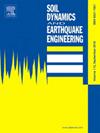Artificial seismic waves generation for complex matching conditions based on diffusion model
IF 4.2
2区 工程技术
Q1 ENGINEERING, GEOLOGICAL
引用次数: 0
Abstract
In the process of random seismic response analysis of structures, a large number of artificial seismic waves compatible with the design response spectrum are required. The use of numerical methods can accurately generate artificial seismic waves that meet the matching conditions, but numerical methods have the problem of long-time consumption. A feasible solution is to learn the patterns of the current seismic wave dataset through a generative model, then generate a large number of seismic waves similar to the original dataset through the trained generative model quickly. However, under complex matching conditions and existing small datasets, the generative model may lose effectiveness. The paper proposes a method for quickly and accurately generating artificial seismic waves under complex matching conditions, which achieves precise compatibility with matching conditions through an existing small dataset of artificial seismic waves and a constructed diffusion model. Numerical example shows that the method proposed in this paper improves computational efficiency by two orders of magnitude compared to numerical methods without sacrificing accuracy, and the performance of the model is better than that of existing generative adversarial models. The method proposed in this paper is applied to the expansion process of an artificial seismic wave dataset for a nuclear power structure, achieving accurate matching under complex matching conditions and improving the diversity of the artificial seismic wave dataset. By reducing the correlation coefficient between the curves in the training dataset or increasing the scale of the training dataset, the generation efficiency of DDPM can be improved. It is also essential to ensure sufficient training epochs and sampling steps to maintain the generation efficiency of DDPM.
求助全文
约1分钟内获得全文
求助全文
来源期刊

Soil Dynamics and Earthquake Engineering
工程技术-地球科学综合
CiteScore
7.50
自引率
15.00%
发文量
446
审稿时长
8 months
期刊介绍:
The journal aims to encourage and enhance the role of mechanics and other disciplines as they relate to earthquake engineering by providing opportunities for the publication of the work of applied mathematicians, engineers and other applied scientists involved in solving problems closely related to the field of earthquake engineering and geotechnical earthquake engineering.
Emphasis is placed on new concepts and techniques, but case histories will also be published if they enhance the presentation and understanding of new technical concepts.
 求助内容:
求助内容: 应助结果提醒方式:
应助结果提醒方式:


